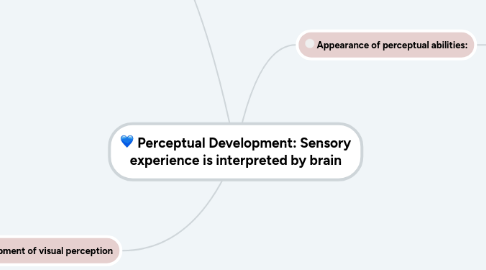
1. Development of senses: Newborns (At birth)
1.1. -Tactile (touch) -Olfactory (smell & taste) -Auditory(listen)
1.2. Smell discrimination
1.2.1. Marlier, Schaal, & Soussignan (1998
1.2.1.1. EX1:Recognize Mother’s Taste
1.2.1.1.1. Mothers had anise flavored food during late pregnancy vs. Mothers did not
1.2.1.1.2. Result:Babies shown the same preferences
1.2.1.2. Ex2: Amniotic Fluid
1.2.1.2.1. Result:Baby shown the preference to the mother's one
1.3. Auditory discrimination
1.3.1. DeCasper & Fifer, 1980
1.3.1.1. EX1: Recognize Mother’s Voice
1.3.1.1.1. Mother’s voice vs. Strange woman’s voice
1.3.1.1.2. Result:Baby shown the preference to the mother's one
2. Development of visual perception
2.1. Special pattern
2.1.1. • Least developed of senses at birth • Matures rapidly in the first year
2.2. Focus & Acuity
2.2.1. Newborns
2.2.1.1. •Lens is fully developed •But poor control of cilliary muscles睫状肌 •Fovea is immature results in blurry vision
2.2.1.2. Acuity at birth ranges from 20/800 (0.03)-20/400 (0.05)
2.2.1.2.1. Worse than normal adults (1.0, 20/20)
2.2.1.2.2. But good enough to see faces, hands, eyes, etc.
2.2.1.3. Ex: Contrast sensitivity at 2 months
2.3. Depth
2.3.1. Stereopsis
2.3.1.1. Ability to coordinate the vision from each retina into a single 3-d image
2.3.2. Study about ability develop of depth
2.3.2.1. When and How?
2.3.2.2. Eleanor Gibso
2.3.2.2.1. Ex: Visual Cliff
2.3.2.2.2. Infants who assess the depth information refuse to crawl to the deep side
3. Appearance of perceptual abilities:
3.1. Prenatal Experience
3.1.1. Auditory experience
3.1.1.1. Mother’s heart beat/Music & other background noise/Father's voice/
3.1.1.2. Pitch, intensity, & rhythmic patterns well preserved
3.1.2. Other experience
3.1.2.1. Fetus detects light, own body, movement
3.2. Fetus grows within a protected (shielded) environment that permits related the experience
3.2.1. Less buffered by the barriers of amniotic fluid, uterus
3.3. Prenatal Environment
3.3.1. Ex: Tactile, Vestibular, Olfactory, Auditory触觉、前庭、嗅觉、听觉
3.3.1.1. Auditory perception
3.3.1.1.1. 20th week
3.3.1.2. However!!! Visual not much until after birth
3.3.2. Prenatal period: Sensory system in place early
3.4. Prenatal Experience Effect: Animal studies
3.4.1. Recognizing Mother’s Call
3.4.1.1. Ducklings could identify the maternal call of their soon after hatching
3.4.2. Gottlieb (1997)
3.4.2.1. Ex:Auditory Preference Test
3.4.2.1.1. Two groups
3.4.2.1.2. Time: Late prenatal period
3.4.2.1.3. Method: Devocalizing mallard fetuses
3.4.2.2. Results
3.4.2.2.1. •The typical group only recognized the maternal call, •While the deprived one also shown the preference to the chicken call. •However, if two groups exposured to self-vocalization about 15-23 hr tend to show lower ability to recognize both.
3.4.3. Conclusion:
3.4.3.1. •Prenatal experience is critical in developing early learning capacities •Prenatal experience should be broadened to include behaviors generated by self •Prenatal experience also feeds back to our own system and affects development of further behaviors •Prenatal experience can be rich in experiencing sensory stimulation, although some are buffered
